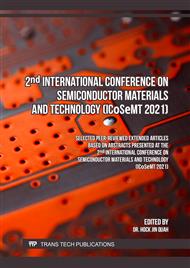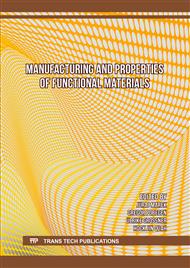[1]
W. T. Prospects, Wireless Technology Prospects and Policy Options. Washington, DC: The National Academies Press, 2011.
Google Scholar
[2]
N. Ivanova, V. Gugleva, M. Dobreva, I. Pehlivanov, S. Stefanov, and V. Andonova, "We are IntechOpen , the world ' s leading publisher of Open Access books Built by scientists , for scientists TOP 1 %," Intech, vol. i, no. tourism, p.13, 2016.
DOI: 10.5772/intechopen.80238
Google Scholar
[3]
S. Picco et al., "Electromagnetic Waves and Human Health," Intech, no. tourism, p.13, 2016, [Online]. Available: https://www.intechopen.com/books/advanced-biometric-technologies/liveness-detection-in-biometrics.
Google Scholar
[4]
D. Lingvay, A. G. Borș, and A. M. Borș, "Electromagnetic pollution and its effects on living matter," EEA - Electroteh. Electron. Autom., vol. 66, no. 2, p.5–11, 2018.
Google Scholar
[5]
J. Hamdard and N. Delhi, "Electromagnetic Pollution," SpringerReference, vol. 2, no. 7, p.61–65, 2011.
DOI: 10.1007/springerreference_13336
Google Scholar
[6]
G. Redlarski et al., "The influence of electromagnetic pollution on living organisms: Historical trends and forecasting changes," Biomed Res. Int., vol. 2015, 2015.
DOI: 10.1155/2015/234098
Google Scholar
[7]
Arthur von Hippel, "Theory and Applications of RF/Microwave Absorbers," Emerson Cuming Microw. Prod. Inc 28, p.1–19, 2012, [Online]. Available: papers2://publication/uuid/E085A757-A5A1-4E1F-BB55-5E616D2EB6B6.
Google Scholar
[8]
O. Joshua, D. S. Matawal, T. D. Akinwumi, K. O. Olusola, A. S. Ogunro, and R. B. Lawal, "Development of a fully pozzolanic binder for sustainable construction: Whole cement replacement in concrete applications," Int. J. Civ. Eng. Technol., vol. 9, no. 2, p.1–2, 2018.
Google Scholar
[9]
A. A. Shakir and A. Ahmed Mohammed, "Manufacturing of Bricks in the Past, in the Present and in the Future: A state of the Art Review," Int. J. Adv. Appl. Sci., vol. 2, no. 3, 2013.
DOI: 10.11591/ijaas.v2i3.1751
Google Scholar
[10]
S. Deraman, "Investigation of compressive strength foam brickwall panel with different bonding by using stretcher & flemish bond," Fac. Civ. Eng. Earth Resour., vol. 66, no. December, p.37–39, 2010.
Google Scholar
[11]
M. A. Yahya et al., "A brief review on activated carbon derived from agriculture by-product," AIP Conf. Proc., vol. 1972, no. June 2018, 2018.
DOI: 10.1063/1.5041244
Google Scholar
[12]
A. M. Giusti, "Pietre dure : hardstone in furniture and decorations," Huria J. Open Univ. Tanzania, vol. 12, no. 1, p.311, 1992, [Online]. Available: https://www.ajol.info/index.php/huria/ article/view/110776/100528.
Google Scholar
[13]
J. Rezania and H. Rahimi, "Investigating the carbon materials' microwave absorption and its effects on the mechanical and physical properties of carbon fiber and carbon black/ polypropylene composites," J. Compos. Mater., vol. 51, no. 16, p.2263–2276, 2017.
DOI: 10.1177/0021998316669578
Google Scholar
[14]
P. Gorbach, S. Shcherbin, and A. Savenkov, "The method of selecting a foaming agent and its concentration in the production of non-autoclaved hard cellular concrete," MATEC Web Conf., vol. 212, 2018.
DOI: 10.1051/matecconf/201821201004
Google Scholar
[15]
M. Franchitto, R. Faez, A. J. F. Orlando, M. C. Rezende, and I. M. Martin, "Electromagnetic behavior of radar absorbing materials based on conducting polymers," SBMO/IEEE MTT-S Int. Microw. Optoelectron. Conf. Proc., no. June 2014, p.137–140, 2001, doi: 10.1109/sbmomo.2001. 1008736.
DOI: 10.1109/sbmomo.2001.1008736
Google Scholar
[16]
P. Dixon, "'Theory and application of RF/microwave absorbers.' Techn. Ber. Emerson & Cuming Microwave Products," p.1–24, 2013.
Google Scholar



